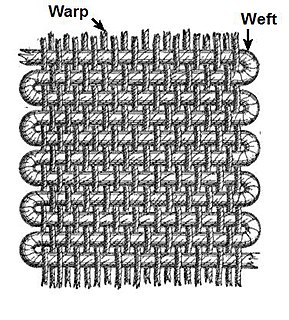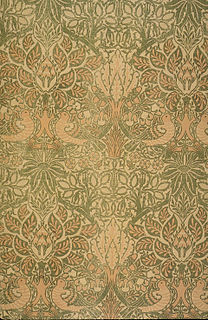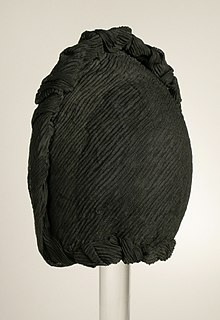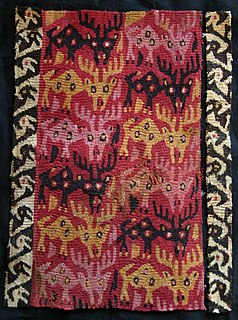
Nun's veiling was a lightweight cloth made of wool. It was a plain weave fabric used mainly for women veils and dresses. Nun's veiling got its name from the fact that it was used in Veils by several religious orders. [1] [2]

Nun's veiling was a lightweight cloth made of wool. It was a plain weave fabric used mainly for women veils and dresses. Nun's veiling got its name from the fact that it was used in Veils by several religious orders. [1] [2]
Nun's veiling was a lightweight, soft, thin, sheer, wool cloth with open weave structure. The construction was more open than a woolen batiste cloth. There were also variants in silk, cotton and mixed materials. [1] [3] [2] [4] [5]
Nun's veiling was used in ladies' toilettes, as a flounce fabric [6] and in a variety of outfits for English women in the 19th century. [7]

Textile is an umbrella term that encompasses a wide range of materials, including fibers, yarns, and fabrics, in addition to filaments, threads, etc. Consumer textiles and technical textiles are the two principal sectors of textile industry. Geotextiles, industrial textiles, medical textiles, and many other areas are examples of technical textiles, whereas clothing and furnishings are examples of consumer textiles. Each component of a textile product, including fiber, yarn, fabric, processing, and finishing, has an effect on the final product. Components may vary between various textile products as they are selected based on fitness for purpose.

Weaving is a method of textile production in which two distinct sets of yarns or threads are interlaced at right angles to form a fabric or cloth. Other methods are knitting, crocheting, felting, and braiding or plaiting. The longitudinal threads are called the warp and the lateral threads are the weft, woof, or filling. The method in which these threads are interwoven affects the characteristics of the cloth. Cloth is usually woven on a loom, a device that holds the warp threads in place while filling threads are woven through them. A fabric band that meets this definition of cloth can also be made using other methods, including tablet weaving, back strap loom, or other techniques that can be done without looms.

Flannel is a soft woven fabric, of various fineness. Flannel was originally made from carded wool or worsted yarn, but is now often made from either wool, cotton, or synthetic fiber. Flannel is commonly used to make tartan clothing, blankets, bed sheets, and sleepwear.

Double cloth or double weave is a kind of woven textile in which two or more sets of warps and one or more sets of weft or filling yarns are interconnected to form a two-layered cloth. The movement of threads between the layers allows complex patterns and surface textures to be created.

Crêpe, also spelled crepe or crape is a silk, wool, or synthetic fiber fabric with a distinctively crisp and crimped appearance. The term "crape" typically refers to a form of the fabric associated specifically with mourning. Crêpe was also historically called "crespe" or "crisp".

Ninon is a lightweight, sheer fabric made with plain or leno weaving, it is a suitable material for curtains, evening wear and lingerie. Ninon is made with variety of filament yarns such as polyester, silk, rayon or nylon.

Organdy or Organdie is a kind of sheer fabric. It is a lightweight balanced plain weave cotton with features of sheerness and crispness.
Maya textiles (k’apak) are the clothing and other textile arts of the Maya peoples, indigenous peoples of the Yucatán Peninsula in Mexico, Guatemala, Honduras, El Salvador and Belize. Women have traditionally created textiles in Maya society, and textiles were a significant form of ancient Maya art and religious beliefs. They were considered a prestige good that would distinguish the commoners from the elite. According to Brumfiel, some of the earliest weaving found in Mesoamerica can date back to around 1000-800 B.C.E.
The manufacture of textiles is one of the oldest of human technologies. To make textiles, the first requirement is a source of fiber from which a yarn can be made, primarily by spinning. The yarn is processed by knitting or weaving, which turns yarn into cloth. The machine used for weaving is the loom. For decoration, the process of colouring yarn or the finished material is dyeing. For more information of the various steps, see textile manufacturing.

The study of the history of clothing and textiles traces the development, use, and availability of clothing and textiles over human history. Clothing and textiles reflect the materials and technologies available in different civilizations at different times. The variety and distribution of clothing and textiles within a society reveal social customs and culture.

In sewing and dressmaking, a ruffle, frill, or furbelow is a strip of fabric, lace or ribbon tightly gathered or pleated on one edge and applied to a garment, bedding, or other textile as a form of trimming.

Fashion in fourteenth-century Europe was marked by the beginning of a period of experimentation with different forms of clothing. Costume historian James Laver suggests that the mid-14th century marks the emergence of recognizable "fashion" in clothing, in which Fernand Braudel concurs. The draped garments and straight seams of previous centuries were replaced by curved seams and the beginnings of tailoring, which allowed clothing to more closely fit the human form. Also, the use of lacing and buttons allowed a more snug fit to clothing.

Jersey is a knit fabric used predominantly for clothing manufacture. It was originally made of wool, but is now made of wool, cotton, and synthetic fibers.
Sewing is the craft of fastening or attaching objects using stitches made with needle and thread. Sewing is one of the oldest of the textile arts, arising in the Paleolithic Era. Although usually associated with clothing and household linens, sewing is used in a variety of crafts and industries, including shoemaking, upholstery, sailmaking, bookbinding and the manufacturing of some kinds of sporting goods. Sewing is the fundamental process underlying a variety of textile arts and crafts, including embroidery, tapestry, quilting, appliqué and patchwork.

Cameline was a fabric material used in the Middle Ages for cloth. By tradition it is commonly thought to have been originally made of camel's hair in Asia. It was imported from Cyprus and Syria into Europe. Cameline is described also as a cloak of the Arabs made of camel's hair which is oftentimes striped white and brown in color. Since history records it many times as a "common and cheap" textile it is thought that it was an imitation of the original Asian camel's hair fabric. It was sometimes a lower quality French cloth imitation made of goat's hair. The fibers were spun into yarn and produced in Flanders and the Duchy of Brabant in many colors in medieval times. It is also described as a warm light woolen textile of camel's hair combined with wool or cotton. It is considered of lesser quality than that of camlet, which is also made of camel's hair.

Textile arts of indigenous peoples of the Americas are decorative, utilitarian, ceremonial, or conceptual artworks made from plant, animal, or synthetic fibers by native peoples of both North and South America.
Barege (Barège) was a lightweight, sheer fabric matching a gauze. It was a union fabric made of silk and wool. Barege ws a 19th-century fabric and originated from southwestern France. It takes its name from the town of Barèges but was mostly made in the town of Bagnères-de-Bigorre.
Etamine is a loosely woven fabric with a similar structure to voile or a mesh. It is an open fabric structure manufactured with plain weaving by using hardly twisted cotton or wool yarns. There were further variations including various fibres such as silk. Etamine was initially used as filter cloth, but became popular in women's skirts from 1910. Etamine was used in a variety of applications, including garments, nun's veils, and even flags.
Radzimir was a kind of silk serge, and It had been dyed black. Radzimir was an elegant silk material created particularly for mourning purposes. Radzimir was a fine, sturdy, and lustrous structure made of plain weave and ribbed weft.The name of the fabric is related to the French "Ras de Saint-Maur", which was a term used to designate a silk dress fabric from the 18th century. The fabric was entirely made of silk, silk, and fteuret, or wool warp and silk in filling.
Delaine was a kind of mixed cloth with cotton warp and wool in the weft. Delaines have many variations such as made of undyed yarns, and also printed or piece dyed. Delaine was a type of cloth used to manufacture women's dresses that was traded in the nineteenth century under many names to suit importers and traders. Moreover, it appeared that the plaintiffs' goods differed from delaines in various other respects.
| Look up nun's veiling in Wiktionary, the free dictionary. |